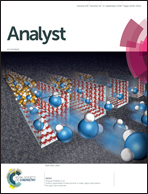Aggregation enhanced excimer emission (AEEE) of benzo[ghi]perylene and coronene: multimode probes for facile monitoring and direct visualization of micelle transition†
Abstract
We report benzo[ghi]perylene (BzP) and coronene (Cron) as multimode fluorescent probes for accurate monitoring and direct visualization of monomer–micelle transitions in surfactants for the first time. The probe molecules formed self-assembled nanoparticles in an aqueous solution and displayed strong aggregation-enhanced excimer emission (AEEE). During the process of surfactant monomer–micelle transition, the probe nanoparticles dissolved, and the observation of excimer–monomer emission transition clearly indicated the formation of micelles. The ratiometric changes in excimer–monomer emission (IE/IM) were used for the precise determination of critical micelle concentration (CMC) of various surfactants. The monomer–micelle transition process was directly observed under a UV lamp, and the visual determination of CMC became possible. The CMC value determination using the excimer/monomer ratio (IE/IM), UV-vis, lifetime and visual assessment clearly suggests that BzP and Cron are excellent multimode probes for monitoring the micelle structural transitions of amphiphiles.
![Graphical abstract: Aggregation enhanced excimer emission (AEEE) of benzo[ghi]perylene and coronene: multimode probes for facile monitoring and direct visualization of micelle transition](/en/Image/Get?imageInfo.ImageType=GA&imageInfo.ImageIdentifier.ManuscriptID=C8AN01070F&imageInfo.ImageIdentifier.Year=2018)


 Please wait while we load your content...
Please wait while we load your content...